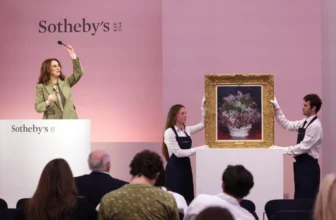
When Is the Right Time to Sell an Antique Painting
How to Know Its True Value and Find the Best Way to Sell It
| Invest in Hidden Masterpiece: Rare Antique Oil Paintings For Sale. Limited Originals Available 💰😊 Are you looking for authentic hidden masterpiece? Explore old master antique oil paintings from the Renaissance and Baroque eras. From 16th-century portraits to 18th-century landscapes. Authenticity guaranteed, Old Master antique oil paintings for sale. Shop Now! 🎨 Renaissance And Baroque Art Landscape Antique Paintings Old Master Portrait Paintings |
Every antique painting tells a story , not only through its brushstrokes and pigments but through the generations that have owned it. Yet, for every collector or heir who inherits an old canvas, a common question arises: “When is the right time to sell my antique painting?”
The art market can be as unpredictable as it is fascinating. Prices fluctuate with trends, provenance discoveries, global demand, and even shifts in taste. Whether you own a Renaissance portrait, a 19th-century landscape, or a forgotten modernist piece, knowing when and how to sell it can make the difference between a modest sale and a life-changing windfall.
In this comprehensive guide, we’ll explore how to evaluate whether your old painting is valuable, the best timing to sell it, and the most effective selling methods used by professional art dealers. By the end, you’ll have a clear strategy to maximize your antique painting’s worth.
Understanding the Value of an Antique Painting
Before deciding when to sell, it’s crucial to know what you have. The value of an antique painting depends on a combination of artist recognition, authenticity, condition, provenance, rarity, and market demand.
1. Artist and Attribution
Paintings by well-known artists , such as J.M.W. Turner, John Constable, or Mary Cassatt , naturally command high prices. However, the art world also rewards rediscoveries: unsigned works that are later attributed to famous artists can increase exponentially in value.
If you’re uncertain about the artist, seek a professional art appraisal or an attribution assessment. Specialists analyze brushwork, materials, and style to determine authorship. Sometimes a simple signature verification can transform a forgotten painting into a masterpiece worth hundreds of thousands.
2. Authenticity and Documentation
Collectors and auction houses place enormous value on provenance , the documented history of a painting’s ownership. Provenance not only confirms authenticity but also connects a work to a historical narrative.
If you have old receipts, gallery labels, or exhibition catalogs mentioning your piece, preserve them carefully. These documents can significantly boost both credibility and price.
3. Condition and Restoration
Condition plays a decisive role in valuation. Cracks, yellowed varnish, or flaking paint might lower the immediate sale price but can sometimes be mitigated through professional restoration.
However, avoid amateur restoration attempts. An untrained touch-up can permanently damage the artwork and reduce its value. Always consult a certified conservator before any cleaning or repair work.
4. Historical and Aesthetic Importance
Some paintings hold value because they capture important historical moments or artistic innovations. A well-painted but unknown portrait may not sell for much , yet a similar-quality piece representing a key cultural era might attract museums or major collectors.
Understanding where your artwork fits within art history can help you market it more effectively and choose the right time to sell.
When Is the Right Time to Sell an Antique Painting?
Timing can transform an average sale into a lucrative one. The art market is cyclical and influenced by external economic and cultural factors. Knowing these dynamics helps you choose the best moment to sell.
1. When the Market Demand Is Strong
Art trends shift. For example, early 20th-century impressionist works dominated the market for decades, but recent years have seen growing interest in modernist, surrealist, and even post-war abstract paintings.
Monitor auction results from major houses such as Sotheby’s, Christie’s, or Bonhams. If similar works are fetching high prices, that’s a strong indicator of market demand. Selling during a trend upswing often yields the best return.
2. When the Artist’s Reputation Rises
If the artist’s work is featured in a major exhibition, retrospective, or museum acquisition, public attention , and prices , tend to rise. For example, rediscoveries of women artists or under-represented schools of art have significantly increased values in the last decade.
Keep an eye on art news and museum press releases. Selling when the artist’s name is circulating in the media can significantly boost your chances of achieving a record price.
3. During a Favorable Economic Climate
Art is considered both a cultural asset and an investment. During times of economic confidence, collectors are more willing to spend. Conversely, in downturns, buyers tend to be cautious, and prices can stagnate.
If global or regional economies are strong and luxury markets are thriving, it’s usually an ideal time to list your antique painting for sale.
4. When You Have Completed Proper Authentication
Never rush to sell before confirming authenticity and provenance. Paintings sold prematurely without verification often fetch only a fraction of their true value.
Once you have documentation and expert authentication, you can approach high-end dealers or auction houses with confidence , and negotiate from a position of strength.
5. When Personal Circumstances Align
Beyond market conditions, your own timing matters. If you’re downsizing, managing an estate, or funding a new investment, selling at a professionally appraised fair value might make sense , even if the market is neutral.
However, avoid urgent “fire sales.” Patience and preparation nearly always lead to better financial outcomes.
How to Know If Your Old Painting Is Worth Money
Determining value involves more than instinct or appearance. Many old paintings may be decorative rather than collectible , but some hold hidden fortunes. Here’s how to assess yours systematically.
1. Conduct Preliminary Research
Start by examining the back of the painting. Labels, inscriptions, and stamps may indicate galleries or exhibitions. Search the artist’s name (if visible) in online art databases such as Artprice, AskART, or Artnet to see recent auction results.
If you find comparable paintings selling for significant sums, your artwork might also hold value.
2. Look for Quality and Technique
High-value paintings often display superior craftsmanship , confident brushstrokes, harmonious composition, and skillful use of light. Even if the artist is lesser known, technical mastery can attract collectors.
Professional dealers can recognize artistic quality instantly, but even a careful self-inspection under good lighting can reveal signs of expertise.
3. Get a Professional Appraisal
A formal appraisal from a certified art appraiser provides an objective estimate based on market data and expert opinion. Choose an appraiser affiliated with organizations such as the International Society of Appraisers (ISA) or the Appraisers Association of America (AAA).
Appraisers will evaluate the artist, medium, subject matter, provenance, and current demand to produce a written valuation report , essential for selling, insurance, or estate planning.
4. Compare Past Auction Results
Auction databases are invaluable. Search for paintings by the same artist or of similar style and date. Look at both high and low estimates.
Remember that private sales often achieve different results than auctions; still, these comparisons help establish a realistic price range.
5. Seek Expert Opinions
If the painting appears significant, consult multiple experts , dealers, curators, and specialists. A consensus of opinions increases confidence in your artwork’s potential.
Sometimes, an expert might even facilitate introductions to collectors or auction houses interested in that specific genre.
What Is the Best Way to Sell an Antique Painting?
Once you understand your painting’s value and timing, the next step is choosing the right sales channel. Each option , gallery, auction, private sale, or online platform , has distinct advantages.
1. Selling Through a Reputable Auction House
Auction houses are often the most prestigious and effective venues for high-value paintings. Sotheby’s, Christie’s, Bonhams, and Heritage Auctions specialize in marketing artworks to a global audience of collectors.
Advantages:
Professional authentication and cataloging
Extensive marketing to qualified buyers
Transparent public sale results
Potential for bidding wars that raise final prices
Considerations:
Commission fees typically range from 10–25%
Strict consignment schedules
Market risk if demand is low at the time of sale
If your painting is likely to sell above $5,000, an auction house is often the best path. Always request a pre-sale estimate and discuss reserve prices before signing consignment agreements.
2. Selling Through a Fine Art Gallery or Dealer
For mid-range or niche paintings, established art galleries can be excellent intermediaries. They provide personal attention, ongoing client relationships, and discreet transactions.
Advantages:
Targeted buyer networks
Potential for long-term representation
Guidance on pricing and presentation
Considerations:
Commission fees (20–50%)
Longer sales timelines
Need for exclusivity agreements
Look for galleries that specialize in the same era or style as your painting , for example, 19th-century European art, American Impressionism, or Modernist works.
3. Private Sales and Collectors
Private sales allow for confidentiality and flexible negotiation. Dealers or art advisors often act as intermediaries, connecting sellers with collectors who prefer not to buy publicly.
Advantages:
Privacy and control over pricing
Potentially lower commission fees
Direct relationships with collectors
Considerations:
Requires market knowledge or professional assistance
Less transparency than auctions
Risk of undervaluation if not handled professionally
For rare or sensitive artworks, private sales can be the most effective route, especially if you work with a reputable art advisor.
4. Online Art Marketplaces
In the digital age, online platforms like Artnet Auctions, 1stDibs, or Invaluable allow sellers to reach international audiences. These platforms have democratized the art market, making it easier for smaller collectors to sell antique paintings.
Advantages:
Global exposure
Lower barriers to entry
Convenient and fast
Considerations:
Risk of counterfeits on less-regulated sites
Commission or listing fees
Difficulty establishing authenticity without physical inspection
If you choose an online sale, provide high-quality photographs, detailed descriptions, and proof of provenance. Transparency builds trust with buyers and increases your chance of success.
5. Estate Sales or Local Auctions
For lower-value or decorative artworks, local estate sales or regional auctions can provide quick results. While prices may be modest, these venues are efficient for clearing collections or selling minor pieces.
How to Prepare Your Antique Painting for Sale
Presentation can significantly influence a buyer’s perception , and the final price. Before listing or consigning your artwork, take these steps:
Document everything – Photograph the painting from all angles, including close-ups of the signature, frame, and reverse side. Keep digital and printed records.
Get a condition report – If the work has cracks, flaking, or fading, obtain a conservator’s assessment.
Avoid over-cleaning – Resist the urge to “improve” its appearance. Leave cleaning or varnish removal to professionals.
Frame appropriately – A period-appropriate frame enhances visual appeal and authenticity.
Gather provenance materials – Collect all paperwork, exhibition catalogs, and receipts to present with the artwork.
A well-documented, professionally presented painting not only sells faster but also inspires buyer confidence.
Maximizing Profit: Expert Tips from Art Dealers
Work with specialists. Choose dealers or auction departments that focus on your painting’s era or style. Their existing clientele increases your chance of a strong sale.
Be patient. Fine art sales can take months. Rushing often leads to undervaluation.
Negotiate commissions. Fees are often flexible, especially for high-value pieces.
Follow the market. Track comparable sales and adjust expectations accordingly.
Consider tax implications. Consult an accountant experienced in art transactions to handle capital gains or inheritance issues.
Insure your artwork. Before transport or exhibition, ensure it’s protected under an updated insurance policy.
Common Mistakes to Avoid When Selling an Antique Painting
Selling without an appraisal – This often leads to undervaluation.
Attempting DIY restoration – Amateur cleaning can permanently damage the painting.
Ignoring provenance – Missing documents can reduce value dramatically.
Using unverified online platforms – Risk of scams or non-payment.
Setting unrealistic prices – Overpricing can deter serious buyers.
Neglecting presentation – Poor photography or framing can undermine even valuable art.
Avoiding these pitfalls ensures a smoother, more profitable selling experience.
Turning an Heirloom into Opportunity
Selling an antique painting is both an emotional and financial decision. Understanding its value, timing the sale strategically, and choosing the right platform can transform your artwork from a forgotten heirloom into a meaningful asset.
If you suspect your painting may hold value, begin with a professional appraisal. Research the artist, monitor the market, and don’t rush the process. The right preparation and patience often yield the best results.
Remember: in the art world, knowledge is profit. The more you understand your painting’s story, authenticity, and timing, the better equipped you are to achieve a sale worthy of its history and beauty.




